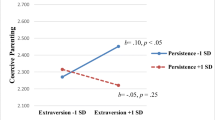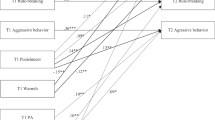Abstract
In order to advance our understanding of the etiology of individual differences in child maladjustment (i.e., conduct and emotional problems), we tested hypotheses about the statistical interactions between child temperament and two aspects of the family environment: maternal negativity and positivity, and household chaos (e.g., crowding, noise, lack of routines). Mothers (n = 149) reported on their child’s effortful control, negative affect, surgency, and behavioral/emotional problems. The age range of the children was 3 to 7 years old and half of the sample was girls. Observers rated maternal negativity and positivity based on brief structured interaction tasks in the laboratory. Child temperament moderated the association between maternal negativity/positivity and child maladjustment. Maternal negativity and child problem behavior were associated only for those children who also were high in surgency or negative affectivity. Maternal positivity was associated with less child problem behavior for those high in surgency. Child effortful control interacted with both maternal negativity and chaos. Maternal negativity and child problem behavior were most strongly associated for children who were low in effortful control and living in chaotic homes. The results point to distinct transactions between child temperament and maternal negativity/positivity that depend in part on the dimensions of temperament and parenting behavior in question.




Similar content being viewed by others
References
American Psychological Association, Task Force on Socioeconomic Status. (2007). Report of the APA task force on socioeconomic status. Washington, DC: American Psychological Association.
Bakeman, R., & Gottman, J. M. (1986). Observing interaction: An introduction to sequential analysis. Cambridge: Cambridge University Press.
Bates, J. E. (2001). Adjustment style in childhood as a product of parenting and temperament. In T. D. Wachs, T. D. Wachs, & G. A. Kohnstamm (Eds.), Temperament in context (pp. 173–200). Mahwah: Erlbaum.
Bell, R. Q. (1968). A reinterpretation of the direction of effects in studies of socialization. Psychological Review, 75, 81–95.
Belsky, J. (2005). Differential susceptibility to rearing influences: An evolutionary hypothesis and some evidence. In B. Ellis & D. Bjorklund (Eds.), Origins of the social mind: Evolutionary psychology and child development (pp. 139–163). New York: Guilford Press.
Belsky, J., Hsieh, H., & Crnic, K. (1998). Mothering, fathering, and infant negativity as antecedents of boys’ externalizing problems and inhibition at age 3 years: differential susceptibility to rearing experience? Development and Psychopathology, 10, 301–319.
Blair, C., & Diamond, A. (2008). Biological processes in prevention and intervention: the promotion of self-regulation as a means of preventing school failure. Development and Psychopathology, 20, 899–911.
Boyce, W. T., & Ellis, B. J. (2005). Biological sensitivity to context: I. An evolutionary-developmental theory of the origins and functions of stress reactivity. Development and Psychopathology, 17, 271–301.
Bronfenbrenner, U., & Evans, G. W. (2000). Developmental science in the 21st century: emerging theoretical models, research designs, and empirical findings. Social Development, 9, 115–125.
Bronfenbrenner, U., & Morris, P. A. (2006). The bioecological model of human development. In R. M. Lerner (Ed.), Handbook of child development: Vol. 1. Theoretical models of human development (6th ed., pp. 793–828). Hoboken: Wiley.
Brown, G., McBride, B., Bost, K., & Shin, N. (2011). Parental involvement, child temperament, and parents’ work hours: differential relations for mothers and fathers. Journal of Applied Developmental Psychology, 32, 313–322.
Campbell, S. (2006). Maladjustment in preschool children: A developmental psychopathology perspective. In K. McCartney & D. Phillips (Eds.), Handbook of early childhood development (pp. 358–378). Oxford: Blackwell.
Chess, S., & Thomas, A. (1989). Temperament and its functional significance. In S. I. Greenspan & G. H. Pollock (Eds.), The course of life (Early childhood, Vol. 2, pp. 163–227). Madison: International Universities Press.
Coldwell, J., Pike, A., & Dunn, J. (2006). Household chaos - links with parenting and child behavior. Journal of Child Psychology and Psychiatry, 47, 1116–1122. doi:10.1111/j.1469-7610.2006.01655.x.
Coplan, R. J., Bowker, A., & Cooper, S. M. (2003). Parenting daily hassles, child temperament and social adjustment in preschool. Early Childhood Quarterly, 18, 376–395.
Coplan, R. J., Reichel, M., & Rowan, K. (2009). Exploring the associations between maternal personality, child temperament, and parenting: a focus on emotions. Personality and Individual Differences, 46, 241–246. doi:10.1016/j.paid.2008.10.011.
Davis-Kean, P. E. (2005). The influence of parent education and family income on child achievement: the indirect role of parental expectations and the home environment. Journal of Family Psychology, 19, 294–304.
Deater-Deckard, K., & Dodge, K. A. (1997). Externalizing behavior problems and discipline revisited: nonlinear effects and variation by culture, context, and gender. Psychological Inquiry, 8, 161–175.
Deater-Deckard, K., Mullineaux, P. Y., Beekman, C., Petrill, S. A., Schatschneider, C., & Thompson, L. A. (2009). Conduct problems, IQ, and household chaos: a longitudinal multi-informant study. Journal of Child Psychology and Psychiatry, 50, 1301–1308.
Deater-Deckard, K., Chen, N., Wang, Z., & Bell, M. A. (2012a). SES moderates the link between household chaos and maternal executive function. Journal of Family Psychology, 26, 391–399.
Deater-Deckard, K., Wang, Z., Chen, N., & Bell, M. A. (2012b). Maternal executive function, harsh parenting, and child conduct problems. Journal of Child Psychology and Psychiatry, 53, 1084–1091.
Diez–Roux, A. V., Merkin, S. S., Arnett, D., Chambless, L., Massing, M., Nieto, F. J., et al. (2001). Neighborhood of residence and incidence of coronary heart disease. New England Journal of Medicine, 345, 99–106.
Evans, G. W., & Wachs, T. (2009). Chaos and children’s development: Levels of analysis and mechanisms. Washington, DC: American Psychological Association.
Evans, G. W., Gonnella, C., Marcynyszyn, L. A., Gentile, L., & Salpekar, N. (2005). The role of chaos in poverty and children’s socioemotional adjustment. Psychological Science, 16, 560–565. doi:10.1111/j.0956-7976.2005.01575.x.
Goodman, R. (2001). Psychometric properties of the strengths and difficulties questionnaire. Journal of the American Academy of Child and Adolescent Psychiatry, 40, 1337–1345.
Hilt, L. M., Armstrong, J. M., & Essex, M. J. (2012). Early family context and development of adolescent ruminative style: moderation by temperament. Cognition & Emotion, 26, 916.
Holmbeck, G. N. (2002). Post-hoc probing of significant moderational and mediational effects in studies of pediatric populations. Journal of Pediatric Psychology, 27, 87–96.
Jessee, A., Mangelsdorf, S., Shigeto, A., & Wong, M. (2012). Temperament as a moderator of the effects of parental depressive symptoms on child behavior problems. Social Development, 3, 610–617.
Karreman, A., de Haas, S., van Tuijl, C., van Aken, M. A. G., & Deković, M. (2010). Relations among temperament, parenting and problem behavior in young children. Infant Behavior & Development, 33, 39–49.
Kiff, C., Lengua, L., & Zalewski, M. (2011). Nature and nurturing: parenting in the context of child temperament. Clinical Child and Family Psychology Review, 1–51. doi: 10.1007/s10567-011-0093-4
Lahey, B. B., Van Hulle, C. A., Keenan, K., Rathouz, P. J., D’Onofrio, B. M., Rodgers, J. L., et al. (2008). Temperament and parenting during the first year of life predict future child conduct problems. Journal of Abnormal Child Psychology, 36, 1139–1158.
Lemery, K., Essex, M., & Smider, N. (2002). Revealing the relation between temperament and behavior problem symptoms by eliminating measurement confounding: expert ratings and factor analyses. Child Development, 73, 867–882.
Lengua, L. J. (2006). Growth in temperament and parenting as predictors of adjustment during children’s transition to adolescence. Developmental Psychology, 42, 819–832.
Maccoby, E. E. (1999). The uniqueness of the par ent-child relationship. In W. A. Collins & B. Laursen (Eds.), Minnesota symposia on child psychology (Relationships as developmental contexts, Vol. 30, pp. 157–175). Hillsdale: Erl baum.
Matheny, A. P., Wachs, T. D., Ludwig, J. L., & Phillips, K. (1995). Bringing order out of chaos: psychometric characteristics of the confusion, hubbub, and order scale. Journal of Applied Developmental Psychology, 16, 429–444. doi:10.1016/0193-3973(95)90028-4.
Mokrova, I., O’Brien, M., Calkins, S. D., & Keane, S. P. (2010). Parental ADHD symptomology and ineffective parenting: the connecting link of home chaos. Parenting: Science and Practice, 10, 119–135.
Morris, A. S., Silk, J. S., Steinberg, L., Sessa, F. M., Avenevoli, S., & Essex, M. J. (2002). Temperamental vulnerability and negative parenting as interacting of child adjustment. Journal of Marriage and the Family, 64, 461–471.
Oldehinkel, A. J., Hartman, C. A., Ferdinand, R. F., Verhulst, F. C., & Ormel, J. (2007). Effortful control as a modifier of the association between negative emotionality and adolescents’ mental health problems. Development and Psychopathology, 19, 523–539.
Olson, S. L., Sameroff, A. J., Kerr, D. C. R., Lopez, N. L., & Wellman, H. M. (2005). Developmental foundations of externalizing problems in young children: the role of effortful control. Development and Psychopathology, 17, 25–45.
Paterson, G., & Sanson, A. (1999). The association of behavioural adjustment to temperament, parenting and family characteristics among 5-year old children. Social Development, 8, 293–309.
Patterson, G., DeBarsyshe, B., & Ramsey, E. (1989). A developmental perspective on antisocial behavior. American Psychologist, 44, 329–335.
Pike, A., Iervolino, A. C., Eley, T. C., Price, T. S., & Plomin, R. (2006). Environmental risk and young children’s cognitive and behavioral development. International Journal of Behavioral Development, 30, 55–66. doi:10.1177/0165025406062124.
Putnam, S. P., & Rothbart, M. K. (2006). Development of short and very short forms of the children’s behavior questionnaire. Journal of Personality Assessment, 87, 102–112.
Putnam, S. P., Sanson, A. V., & Rothbart, M. K. (2002). Child temperament and parenting. In M. H. Bornstein (Ed.), Handbook of parenting (Children and parenting, Vol. 1, pp. 255–277). Mahwah, NJ: Erlbaum.
Rothbart, M. K., & Bates, J. E. (2006). Temperament in children’s development. In W. Damon, R. Lerner, & N. Eisenberg (Eds.), Handbook of child psychology volume 3, social, emotional, and personality development (6th ed.). New York: Wiley.
Sameroff, A. J., Seifer, R., Barocas, R., Zax, M., & Greenspan, S. (1987). Intelligence quotient scores of 4-year-old children: social-environmental risk factors. Pediatrics, 79, 343–350.
Stice, E., & Barrera, M. (1995). A longitudinal examination of the reciprocal relations between perceived parenting and adolescent substance use and externalizing behaviors. Developmental Psychology, 31, 322–334.
Webster-Stratton, C., Reid, M. J., & Stoolmiller, M. (2008). Preventing conduct problems and improving school readiness: evaluation of the Incredible Years teacher and child training programs in high-risk schools. Journal of Child Psychology and Psychiatry, 49, 471–488.
Acknowledgments
We thank the study participants and research staff. This research was supported by the Eunice Kennedy Shriver National Institute of Child Health and Human Development grants HD57319 and HD60110. The content is solely the responsibility of the authors and does not necessarily represent the official views of the NICHD or National Institutes of Health.
Author information
Authors and Affiliations
Corresponding author
Rights and permissions
About this article
Cite this article
Chen, N., Deater-Deckard, K. & Bell, M.A. The Role of Temperament by Family Environment Interactions in Child Maladjustment. J Abnorm Child Psychol 42, 1251–1262 (2014). https://doi.org/10.1007/s10802-014-9872-y
Published:
Issue Date:
DOI: https://doi.org/10.1007/s10802-014-9872-y




